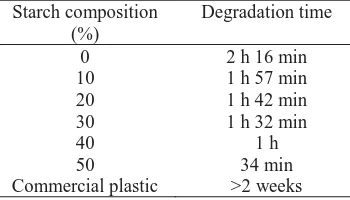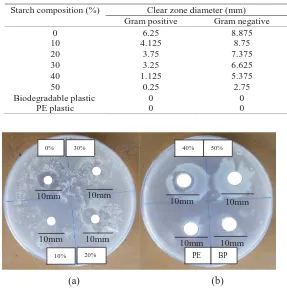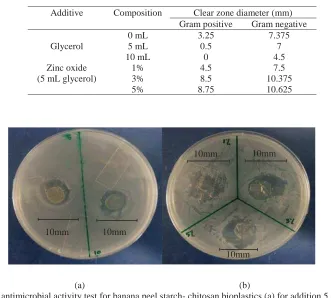IOP Conference Series: Materials Science and Engineering
PAPER • OPEN ACCESS
,QQRYDWLRQLQ3RO\PHU6FLHQFHDQG7HFKQRORJ\
,367
To cite this article: 2017 IOP Conf. Ser.: Mater. Sci. Eng. 223 011001
View the article online for updates and enhancements.
Related content
2nd International Conference on Innovation in Engineering and Vocational Education (ICIEVE 2017)
-Green design application on campus to enhance student’s quality of life
H Tamiami, F Khaira and A Fachrudin
-Polymer science supported
1
Content from this work may be used under the terms of theCreative Commons Attribution 3.0 licence. Any further distribution of this work must maintain attribution to the author(s) and the title of the work, journal citation and DOI.
Published under licence by IOP Publishing Ltd
1234567890
Innovation in Polymer Science and Technology 2016 (IPST 2016) IOP Publishing IOP Conf. Series: Materials Science and Engineering 223 (2017) 011001 doi:10.1088/1757-899X/223/1/011001
P R E F A C E
International Conference on Innovation in Polymer Science and Technology 2016 (IPST2016)
/ƚ ŝƐ ǁŝƚŚ ŐƌĞĂƚ ƉůĞĂƐƵƌĞ ƚŚĂƚ ǁĞ ŝŶƚƌŽĚƵĐĞ ƚŚŝƐ ƐƉĞĐŝĂů ŝƐƐƵĞ ŽĨ ƚŚĞ /KW ŽŶĨĞƌĞŶĐĞ ^ĞƌŝĞƐ͗
With our warm regards,
Rike Yudianti (Indonesian Institute of Science) Jun-ichi Azuma (Osaka University, Japan)
--- Editor-in-Chief
IOP Conference Series: Materials Science and Engineering
PAPER • OPEN ACCESS
/LVWRI&RPPLWWHH
To cite this article: 2017 IOP Conf. Ser.: Mater. Sci. Eng. 223 011002
View the article online for updates and enhancements.
Related content
List of committees
-Organizing Committee
-COMMITTEES
1
Content from this work may be used under the terms of theCreative Commons Attribution 3.0 licence. Any further distribution of this work must maintain attribution to the author(s) and the title of the work, journal citation and DOI.
Published under licence by IOP Publishing Ltd
1234567890
Innovation in Polymer Science and Technology 2016 (IPST 2016) IOP Publishing IOP Conf. Series: Materials Science and Engineering 223 (2017) 011002 doi:10.1088/1757-899X/223/1/011002
COMMITTEE
INTERNATIONAL ADVISORY BOARD Jun-Ichi Azuma (Japan)
Buvanesh Gupta (India) Sunit Hendrana (Indonesia)
Sarifah Fauziah Syed Draman (Malaysia) Katja Loos (Germany) Akhmad Herman Yunono (FT-UI) Anne Zulfia (FT-UI)
Sri Harjanto (FT-UI)
Sudirman (Chairman of Advisory Board of HPI) Agus Haryono (President of HPI)
Akhmad Zainal Abidin (ITB) Cynthia L. Radiman (ITB) Lies A. Wisojodharmo (BPPT)
Koentari Adi Soehardjo (B4T-Kemenperin) Bambang Widiyatmoko (LIPI)
Rochmadi (UGM) Nursyamsu Bahar (HPI) Basuki Wirjosentono (USU) Hendig Winarno (BATAN)
Eniya Listiani Dewi (Deputy of TAB-BPPT) Asrin Lubis (UNIMED)
Krisna Surya Bhuana (HPI)
Bambang Lelono Widjantoro (FT-ITS) Umar Habson BBKK-Kemenperin)
EDITORIAL BOARD
Chief-in-Editor : Rike Yudianti (Indonesia) Editorial Member : Jun-ichi Azuma (Japan) Rameshwar Adikari (Nepal)
Wu Guozhong (China) Katja Loos (Netherland) Md. Akil Hazizan (Malaysia) Ishak bin Ahmad (Malaysia) I Made Arcana (Indonesia)
Md. Abu Bin Hasan Susan (Bangladesh) Ji Heung Kim (Korea)
Sunit Hendrana (Indonesia) Mochamad Chalid (Indonesia) Hermawan Judawisastra (Indonesia) Lorenzo Massimo Polgar (Netherlands) Nadras Othman (Malaysia)
Wilairat Cheewasedtham (Thailand) Sudaryanto (Indonesia)
2
1234567890
Innovation in Polymer Science and Technology 2016 (IPST 2016) IOP Publishing IOP Conf. Series: Materials Science and Engineering 223 (2017) 011002 doi:10.1088/1757-899X/223/1/011002
ORGANIZING COMMITTEE Chairman : Mochamad Chalid
Co-chair : Eddyanto
Secretary : Yenny Meliana
Members :
Evi Triwulandari Lisman Suryanegara Heru Susanto
Sri Fahmiati Yuyun Nurhamiyah Indriyati
Melati Septiyanti Wiwik Pujiastuti M. Ghozali
Elsy Rahimi Chaldun Guntarti Supeni Tita Puspitasari
Evana Juanita Dita Adi Saputra Rike Yudianti
Riastuti Fidyaningsih Anung Syampurwadi Myrtha Karina
Tri Partuti Ika Juliana Witta Kartika Restu
Yuyun Irmawati Nuri Astrini Oka Pradipta Arjasa
IOP Conference Series: Materials Science and Engineering
PAPER •OPEN ACCESS
(IIHFWRIJO\FHURODQG]LQFR[LGHDGGLWLRQRQ
DQWLEDFWHULDODFWLYLW\RIELRGHJUDGDEOHELRSODVWLFV
IURPFKLWRVDQNHSRNEDQDQDSHHOVWDUFK
To cite this article: Y E Agustin and K S Padmawijaya 2017 IOP Conf. Ser.: Mater. Sci. Eng. 223 012046
View thearticle onlinefor updates and enhancements.
Related content
Mechanical properties of bioplastics cassava starch film with Zinc Oxide nanofiller as reinforcement
Harunsyah, M Yunus and Reza Fauzan
-Study of the influence of ZnO addition on the properties of chitosan-banana starch bioplastics
L Sapei, K S Padmawijaya, O Sijayanti et al.
-Water absorption and its effect on the tensile properties of tapioca starch/polyvinyl alcohol bioplastics
H Judawisastra, R D R Sitohang, L Marta et al.
1
Content from this work may be used under the terms of theCreative Commons Attribution 3.0 licence. Any further distribution of this work must maintain attribution to the author(s) and the title of the work, journal citation and DOI.
Published under licence by IOP Publishing Ltd
1234567890
Innovation in Polymer Science and Technology 2016 (IPST 2016) IOP Publishing IOP Conf. Series: Materials Science and Engineering 223 (2017) 012046 doi:10.1088/1757-899X/223/1/012046
Effect of glycerol and zinc oxide addition on antibacterial activity of
biodegradable bioplastics from chitosan-kepok banana peel starch
Y E Agustin and K S Padmawijaya
Chemical Engineering Department, University of Surabaya, Surabaya, Indonesia
E-mail: yuana@staff.ubaya.ac.id
Abstract. Bioplastic is a biopolymer plastic that can be degraded easily by microorganisms so it can be used as alternative replaced commercial plastic. This research aims to study the effects of additive (glycerol and zinc oxide) addition in the characteristic of antimicrobial activity and biodegradability bioplastic from chitosan and Kepok banana peel starch. In this research, bioplastics were synthesized by chitosan as the backbone and antimicrobial, Kepok banana peel starch as filler, glycerol as plasticizer, also ZnO as an amplifier. Bioplastics were characterized their antimicrobial activity using agar diffusion method (zone inhibition assay) and biodegradability test using microbe (EM4). The result showed the optimum composition of bioplastic is kitosan 4 - 30% starch –5 mL glycerol –5% ZnO gives the good antimicrobial activity towards gram positive and gram negative bacteria, and this bioplastic will be degraded within an hour and 12 min. Thus, this bioplastics may have potential to be use for food packaging by having biodegradable properties and also inhibit bacterial growth.
1. Introduction
In the last decades there has been an increasing interest in the development of renewable
materials with biodegradable properties in attempt to contribute to the sustainable development and to
reduce the environmental impact of non- biodegradable petroleum based plastics. Bioplastics that are
made from renewable resources which are easily broken down by microorganism represent a new
generation of plastics that can reduces the dependence on fossil fuels also at the same way can reduces
the impact to the environment. In order to solve the problem, several studies have been reported the
use of biodegradable starches from different sources to prepare films and coating with different
properties. Starch is the most important polysaccharide polymer used to develop biodegradable films,
as it has potential to form a continuous matrix. Starch exhibits some disadvantages such as strong
hydrophilic character and poor mechanical properties as compared to conventional synthetic polymers,
which make it an adequate for some packaging purposes [1, 2].
Nowadays, interest in antimicrobial polymer packaging was growing rapidly, especially in field
of medicine, healthcare, and food industry. Antimicrobial polymer packaging is one of the most
promising active packaging systems that used to protect surfaces from microorganism including
parasites, bacteria, germs and fungi. Chitosan has been proved to be nontoxic, biodegradable,
2
1234567890
Innovation in Polymer Science and Technology 2016 (IPST 2016) IOP Publishing IOP Conf. Series: Materials Science and Engineering 223 (2017) 012046 doi:10.1088/1757-899X/223/1/012046
used as a packaging material for the quality preservation of a variety of food [3]. Starch based film is
considered as an economical material for antimicrobial packaging when we blended it with chitosan as
antimicrobial agents. Blended between chitosan with renewable and abundant agro-resource based
such as polysaccharides, particularly starch can be utilized to reduce the manufacturing cost, improved
moisture resistance and accelerated degradation [4].
The aim of the present work was to obtain bioplastics that have antimicrobial ability to restrain
or inhibit the growth of spoilage and or pathogenic microorganisms. Blends between banana peel
starch and chitosan using glycerol as a plasticizer will produce biodegradable plastics that can have
antimicrobial activity towards microorganisms. The antimicrobial effect was tested on Staphylococcus
aureus (gram positive bacteria) and Escherichia coli (gram negative bacteria) using zone of inhibition
test on solid media.
2. Materials and Methods
2.1 Materials
Banana peel starch was isolated from white kepok banana that plenty found in Indonesia using
water as a solvent extraction. Chitosan flakes with 85% de-acetylation degree were used as the
backbone of bioplastics and also antimicrobial agents. Glycerol was used as plasticizer and purchased
from PT. Brataco (Surabaya, Indonesia). NaOH flake technical was purchased from PT. Brataco
(Surabaya, Indonesia). Glacial acetic acid was purchased from PT. Merck (Indonesia). EM4 (Effective
Microorganism 4) solution containing mixed microbial cultures was purchased from PT. Songgolangit
Persada (Indonesia). Deionised water was used during the experiments. Zinc oxide was used as the
filler to strength the bioplastics film.
2.2. Preparation of Chitosan- Starch Bioplastic Film
Starch slurry was prepared by suspending kepok banana peel into water with ratio 1 : 2 (%w/v)
for 10-12 h. Separation between slurry and filtrate was used by filtration method. Slurry was dried at
40oC for 12 h. Chitosan- starch bioplastics were prepared with 4% (w/v) chitosan and various ratio of
starch (0, 10, 20, 30, 40, 50%) (w/w). Both mixtures were prepared by suspending into acetic acid
glacial as the solvent, process was conducted at 55oC. Afterwards, 30 mL of glycerol was added in
order to have chitosan- starch- glycerol ratio of 100 : 30 (v/v). Various additive glycerol (0, 5, 10 mL)
and zinc oxide (1, 3, 5%) (w/v) was added to increase the biodegradability and antimicrobial activity
of bioplastics. At the end, bioplastics casting were conducted by pouring the final mixtures into a petri
1234567890
Innovation in Polymer Science and Technology 2016 (IPST 2016) IOP Publishing IOP Conf. Series: Materials Science and Engineering 223 (2017) 012046 doi:10.1088/1757-899X/223/1/012046
be easily remove out. Bioplastics were then rinsed under flowing water and dried at room temperature
prior to analysis.
2.3. Biodegradability Test
Bioplastics were cut into 2 cm x 2 cm and then were put into petri dish. Afterwards, 20 mL
microbial solution (EM4) which was previously diluted for 5 times was added. The degradation
process such as color and dimension changing were monitored every 30 min.
2.4. Antimicrobial Activity Test
There are several methods to evaluate the antimicrobial activity of the bioplastics. This research
was used disc diffusion (Kirby Baeur) test as antimicrobial activity test for bioplastics film.
Bioplastics with 1 cm diameter were placed on solid nutritive media (nutrient agar) which contain a
suspension of gram positive bacteria (Staphylococcus aureus) or gram negative bacteria (Escherichia
coli) swabbed evenly on its surface. Afterwards, petridish was incubated for 18- 24 h. The incubation
condition depends on the culture that was used on the test. After the incubation period, the inhibitory
zone (clear zone) has to be determined around the bioplastics samples on the agar plate [5].
3. Results and Discussion
3.1. Optimization of Starch Composition to Biodegradable Ability of Banana Peel Starch- Chitosan
Blended Bioplastics
Biodegradable test was also analyzed for commercial plastics as a comparison study. The result
of biodegradability test towards banana peel starch- chitosan bioplastics was provided inside the Table
1 and Figure 1 as follows. Table 1 show the increasing rate of degradable ability of bioplastic when
concentration of starch was increased in bioplastic and the visual degradation process of banana peel
starch- chitosan bioplastic could be seen in Figure 1.
Table 1. Biodegradability test of chitosan- starch bioplastics at various composition of starch (4% Chitosan)
1234567890
Innovation in Polymer Science and Technology 2016 (IPST 2016) IOP Publishing IOP Conf. Series: Materials Science and Engineering 223 (2017) 012046 doi:10.1088/1757-899X/223/1/012046
(a) (b) (c)
Figure 1. Biodegradability Test for 30% Banana Peel Starch- 4% Chitosan- 5 mL glycerol- 5% ZnO Bioplastic (a) at the beginning (b) after 1 h (c) after 1 h and 30 min
3.2. Effect of Glycerol to Biodegradable Ability of Banana Peel Starch- Chitosan Blended
Bioplastics
The effect of glycerol on the biodegradability of banana peel starch- chitosan based bioplastics was
shown in Table 2.
Table 2. Biodegradability Test of Chitosan- Starch Bioplastics (4% Chitosan- 30 % Starch) with Addition of Glycerol
Glycerol (mL)
Degradation time
0 1 h 32 min
5 1 h 7 min
10 31 min
When glycerol was added in the 30% banana peel starch-chitosan bioplastics, the degradablility
of bioplastics film also increased. Glycerol can reduce intermolecular forces in starch or chitosan and
thus decreased the strength of the films significantly [6]. The result indicated that addition of glycerol
which acted as a plasticizer decreased the strength of banana peel starch- chitosan composite films.
3.3. Effect of Zinc Oxide to Biodegradable Ability of Banana Peel Starch- Chitosan Blended
Bioplastics
Zinc oxide was loaded into banana peel starch- chitosan bioplastics as filler. The illustration of
interaction between zinc oxide with starch- chitosan bioplastics was shown in Figure 2.
1234567890
Innovation in Polymer Science and Technology 2016 (IPST 2016) IOP Publishing IOP Conf. Series: Materials Science and Engineering 223 (2017) 012046 doi:10.1088/1757-899X/223/1/012046
The interaction between zinc oxide with bioplastics was a complex metal- chitosan. Zn2+ ion
will become a bridge and substitute for the lost intra and intermolecular hydrogen bond.
Biodegradability rates decreased as the increased of zinc oxide concentration in banana peel
starch-chitosan bioplastics as could be references are clearly legible on the track of IOP Author Guidelines.
Check in composite bioplastics will inhibit bacterial growing and can also decrease the degradation
rate of bioplastics.
Table 3. Biodegradability Test of Chitosan- Starch Bioplastics Zinc oxide
3.4. Antimicrobial Activity of Banana Peel Starch- Chitosan Bioplastics
The results after 24 h incubation time was shown in Table 4 and Figure 3. The inhibitory effect
was measured based on clear zone surrounding circular film disc. Measurement of clear zone diameter
was started from the outside diameter of film bioplastics.
Table 4. Antimicrobial Activity Test of Chitosan- Starch Bioplastics (4% Chitosan)
Starch composition (%) Clear zone diameter (mm) Gram positive Gram negative
Figure 3. Antimicrobial Activity Test for Banana Peel Starch- Chitosan Bioplastics against Gram Positive Bacteria (S. aureus) (a) 0-30% Starch Compositions (b) 40-50% Starch Compositions, Biodegradable Plastic
(BP), and Polyethylene Plastic (PE)
1234567890
Innovation in Polymer Science and Technology 2016 (IPST 2016) IOP Publishing IOP Conf. Series: Materials Science and Engineering 223 (2017) 012046 doi:10.1088/1757-899X/223/1/012046
If there is no clear zone surrounding, it means that there is no inhibitory zone, and the diameter
was valued as zero. Films bioplastics showed fair antibacterial activity against gram positive (S.
aureus) and gram negative (E. coli) bacteria. Commercial biodegradable plastics and polyethylene
(PE) plastic was used as control for antimicrobial activity test. In general as shown on Table 4,
chitosan bioplastics without starch addition will given the biggest clear zone against gram positive and
gram negative bacteria [3]. Antimicrobial activity will decreased as the increased of starch addition on
banana peel starch- chitosan bioplastics. The results were showed that banana peel starch- chitosan
bioplastics have bigger clear zone against E.coli compare to S. aureus. It means banana peel
starch-chitosan bioplastics have more effective antimicrobial activity against gram negative (E. coli) bacteria
than gram positive (S. aureus) bacteria. Commercial biodegradable plastic and polyethylene (PE)
plastic were not showed any antimicrobial activity.
Table 5. Antimicrobial activity test of chitosan- starch bioplastics (4% chitosan- 30% starch) with additive
Additive Composition Clear zone diameter (mm) Gram positive Gram negative
Glycerol
Figure 4. antimicrobial activity test for banana peel starch- chitosan bioplastics (a) for addition 5 and 10 mL of glycerol (b) for addition 1,3,5% of zinc oxide
Addition of glycerol as a plasticizer into chitosan bioplastics was decreased the antimicrobial
activity of bioplastics because glycerol filled the space between hydrogen bond and will weakness the
chitosan strength that can affect chitosan antimicrobial activity. Zinc oxid (ZnO) is an efficient
10mm 10mm
10mm
1234567890
Innovation in Polymer Science and Technology 2016 (IPST 2016) IOP Publishing IOP Conf. Series: Materials Science and Engineering 223 (2017) 012046 doi:10.1088/1757-899X/223/1/012046
antimicrobial agent since zinc oxide was able to exhibit an antimicrobial effect by diffusion of soluble
species into agar medium [7]. Decrease of microbial population with respect to zinc oxide
concentration on banana peel starch- chitosan bioplastics. The antimicrobial activity analysis also
tested for banana peel starch- citosan bioplastics with addition of glycerol and zinc oxide as shown on
Table 5 and Figure 4.
4. Conclusion
Biodegradability increased with the increase of banana peel starch concentration in
starch-chitosan bioplastics. On contrary their antimicrobial activity will decreased. The starch- starch-chitosan based
bioplastics demonstrates more effective antimicrobial activity against gram negative (E. coli) bacteria
than gram positive (S. aureus) bacteria. Addition of glycerol which acted as plasticizer will increase
the biodegradability of bioplastics but at the same time will reduced their antimicrobial activity.
Decreased of microbial growth will respected to zinc oxide concentration because of their
antimicrobial ability. The banana peel starch- chitosan bioplastics may have potential applications for
antimicrobial packaging by their fast biodegradable rate and antimicrobial activity that can inhibit
bacterial growth to improve the food safety.
References
[1] Priya B et al 2014 Carbohydr. Polym. 109 171-179. [2] Mollah M Z I et al 2016 J Organic Polym. Mater. 6 11-24. [3] Tripathi S et al 2008 e-Polymers 093.



